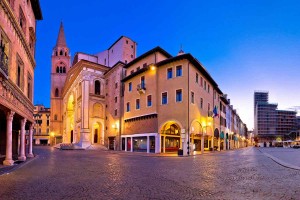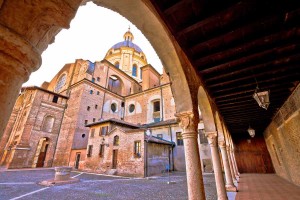
©Bigstock.com/xbrchx
Two towns, one noble bloodline and a World Heritage Site: The old towns of Mantua and Sabbioneta were added to the illustrious UNESCO list in 2008. Both show how town planning and urban development worked in the Renaissance, but in very different ways. The Gonzaga are behind these endeavours. They allowed Mantua and Sabbioneta to blossom from the 14th century onward and far into the 17th century. With the extended and renewed metropolis on one side and the ideal town on the other, they illustrate evolution, revolution and humanistic influence. Time for a not-so-brief trip to Lombardy!
How the Gonzaga became Dukes of Mantua
Let’s start by taking a look at the noble family who left their mark on Mantua and built Sabbioneta. First documentary evidence of the Gonzaga brings us to the 12th century, when they were liegemen to the Duke of Casaloldo for Castle Gonzaga near Mantua. As successors of the Bonacolsi family, they ruled over Mantua from 1328 to 1708 – first as imperial vicars, then as dukes and margraves before Federico II received the title “Duke of Mantua” in 1530. Marriages and acquisitions bestowed Montferrat and Guastalla upon the family seeing them hit the peak of their power around 1539. Vespasiano Gonzaga began building the ideal town Sabbioneta soon after.
When the main branch of the Gonzaga bloodline disappeared in 1627, the War of the Mantuan Succession “chose” their successors. The Habsburg Emperor – the Gonzaga were politically connected to the Habsburg – wanted to assume control of the now vacant imperial fief. However, French intervention brought Mantua to a younger, French cadet branch of the Gonzaga. It only returned to imperial control during the War of Spanish Succession. The duchy was united with the Habsburg Duchy of Milan on 30 June 1708; part of Montferrat was given to the Savoyards. Most Gonzaga cadet branches died out during the 18th century, the only one still existing today being the Gonzaga di Vescovato.
Mantua
When the Gonzaga began their reign over Mantua in the 14th century, they changed the townscape dramatically. The 16th century in particular saw decisive shifts in order the illustrate the wealth and power of the ruling family. The Renaissance brought new ideas with it expanding the existing medieval town rather impressively. You will discover witnesses of this evolution in urban development at every corner ranging from stunning squares to rich embellishments and hidden details. You absolutely must visit the following three buildings:
Palazzo Ducale
The ducal palace is, without a doubt, the heart of Mantua. Its oldest parts – Palazzo del Capitano and Magna Domus – even date back to the Bonacolsi reign with Castello di San Giorgio following shortly after. Even more extensions would be added until the 17th century including Domus Nova, the church Santa Barbara and the palace chapel. Hefty corridors and galleries connect the different building parts which are enhanced greatly by gardens and inner courtyards. As a whole, the brick complex comprises around 500 rooms spread across approx. 34,000 m². A walk through the Palazzo certainly amazes, as you’ll constantly discover even more splendid details and artistic brilliance. The wedding room (“Camera degli Sposi”) in Castello di San Giorgio is an absolute must-see. Andrea Mantegna’s frescoes gained international renown, and with good reason, as you’ll be able to see for yourself.
Mantua Cathedral

©Bigstock.com/xbrchx
This Romanesque five-nave basilica actually dates back to the 9th century, but it was extended decisively in the 15th century under Francesco I Gonzaga. Unfortunately, a devastating fire destroyed most of the cathedral. During the reconstruction in 1545, an early Christian version of St. Peter’s Basilica served as inspiration. The marble façade was only finished over 200 years later. You can still see the old gables and king’s tower from before the fire on the right side, now accompanied by a neoclassical façade. Mantua’s masters of Mannerism left their mark on the stunning interior. Countless breath-taking paintings and works of art even turn the cathedral into a massive art gallery in places.
Basilica of Sant’Andrea
Upon purchasing a Relic of the Holy Blood, Ludovico Gonzaga had an entire church built for it in 1470. It was no other than Reniassance genius Leon Battista Alberti who put the ambitious plans into practice adding elements from Italian antiquity. Chapels replaced the side aisles – a radical innovation for building churches in the Renaissance and the baroque. In order to achieve the monumental effect of his ancient ideals, Alberti implemented an ancient temple front with unusual flat pilasters. The crossing and the tambour cupola were only added in the 18th century. Andrea Mantegna is closely connected to this building as well. You won’t just see his wonderful paintings inside the basilica, but also the tomb of the Renaissance painter.
Sabbioneta
Vespasiano Gonzaga, Duke of Sabbioneta, inherited a castle complex in the 16th century and planned on turning it into a baronial residence. Actually, he created an ideal town following humanistic ideals resulting in the first autonomous founding of a town of the Renaissance period. The massive town wall is particularly impressive, especially for such a fairly small town. It is shaped like an irregular hexagon featuring star-shaped, protruding bastions. The meticulously planned old town was built between 1554 and 1571. Vespasiano wanted to make Sabbioneta a town of art and culture like Athens, yet it was completely neglected after his death and almost fully abandoned soon after. The monuments remained untouched, the urban structure intact.
You can now enter Sabbioneta via the two town gates Porta Vittoria and Porta Imperiale. Splendid churches and monasteries aside, here are some places to visit:
- Palazzo Ducale: There’s also a ducal palace in Sabbioneta. Glorious horse statues and artistically carved wooden ceilings await you.
- Teatro Olimpico: Modelled after the eponymous theatre in Vicenza, it is the first free-standing theatre in Europe built as such. Corinthian pillars with god-like representations resting on their cornices line the gallery.
- Galleria degli Antichi: Vespasiano’s collection of antiquities is among the largest of its kind in Italy. You’ll see the 32 marble statues and 18 busts he inherited from his father and grandfather.
- Palazzo del Giardino: The ducal villa looks rather plain from the outside. However, the amazing view of the garden and the numerous frescoes with historical and mythological scenes spread across 15 painted rooms have many a surprise in store.
Naturally, this is only a small selection of all buildings and sights that await you in the scenic old towns of Mantua and Sabbioneta. Look forward to exciting tours through both Renaissance gems with exciting insights into a truly different time. Lombardy doesn’t get any more beautiful than this!